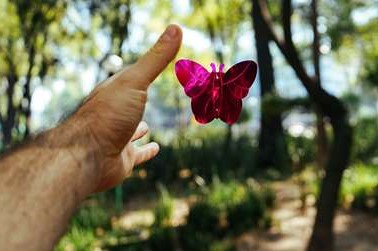 Can virtual reality expand access to nature?
Can virtual reality expand access to nature?
In an unexpected turn of events, technology is bringing us closer to nature than ever. The greatest beneficiaries of this progress are people whose access to nature is physically limited.Science and medicine are coming together in an effort to restore humans’ connection to nature. Virtual reality (VR) simulations of natural environments are on the rise – and are helping humans and nature alike. It might sound counter-intuitive, but the solution to a problem caused by technology may come from technology.
Nature in a bottle
The benefits of physically spending time in nature have long been known, and reach far beyond breathing in fresh, clean air. A 2016 report by the World Health Organisation found that urban green spaces (i.e., vegetation in cities) can be connected to, among other things, physical relaxation and stress reduction. Simply put: a walk in the park makes one happier and mentally healthier. People who have physical difficulty reaching green spaces, such as the elderly, are often deprived of these benefits, however.
During the Covid-19 pandemic, when access to the outside has been limited for many people, the options for bringing nature to people virtually expanded.
Mattias Wallergård, associate professor at the department of design sciences at Lund University, has spent the past 10 years studying ways of bringing the outside indoors, looking at the use of VR as a direct health intervention. Or, as he puts it: “How to bottle up the benefits of real nature in virtual reality for vulnerable populations.” His recent study in a Swedish home for the elderly shows that VR nature needs to be as diverse as those using it.
“There is no one solution that fits everyone,” says Wallergård. “For some people, it works perfectly to run it as a group activity, with one participant wearing the VR glasses and a huge tv-screen that’s following what’s happening in the virtual world. Others need individual experiences.”
VR nature can raise awareness for the environment and for the effects human actions have on it and encourage nature preservation.
Protecting live nature through virtual nature
Numerous studies show that virtual exposure to nature has all the mental health benefits of spending time in it physically. A review study in which Wallergård participated found that VR nature can distract from physical pain (particularly in patients with cancer or chronic pain), reduce stress and anxiety, assist in the treatment of mental health issues such as phobias or post-traumatic stress disorder (PTSD) and, when performed in a group, even improve social connections. Furthermore, it can be beneficial for nature itself.
A study in which high school students experienced the ocean from the point of view of a coral found that VR nature can raise awareness for the environment and for the effects human actions have on it and encourage nature preservation.
One such example is upmforestlife.com – a virtual trip through the Finnish forest, complete with nature sounds, created by UPM. The website, which took about 20 days to film and 18 months to create, is interactive on multiple levels. Visitors can walk through different paths in the woods and immerse themselves in nature. They also have the option to click on various points around them to read a text or watch a video about the diverse species of Finnish forest life, ways to enjoy the forest (such as picking mushrooms or berries) and UPM’s forestry operations – including explanations on forest areas that are kept protected from forestry work for the sake of biodiversity, such as natural mires. While the core idea is to educate people about sustainable forestry, the project reaches far beyond that.
“We thought about people from mega-cities like Shanghai, who have maybe never had the chance to go to a forest, or just people who have mobility limitations,” says Matti Maajärvi, Senior Specialist, Environment, UPM Forest. “We wanted it to not only be a fact bank, but also an experience.”
Beyond expectations
The experience proved so effective that several schools from Brazil, Canada and Finland have contacted Maajärvi for permission to use the website in their study programs.
The company has recently added Carbon Tree Demo to the website. It is a virtual demonstration that shows how much carbon one tree can absorb during its 80-year-long lifecycle and how that amount compares to everyday emissions.
The main concern of VR critics has constantly been that VR nature might seduce its users to forget real nature completely in favour of the simulations. They need not worry: studies have shown that VR can actually increase motivation to experience nature directly.
Wallergård has experienced this first hand. An elderly man in his research at a Lund care home went from viewing virtual bicycle rides in central Lund to wanting to visit these places for real. “He has gone from being very closed, depressed, almost a prisoner, to where we start to see changes in him as a person,” Wallergård says. “It’s like something has been awakened in him.”
